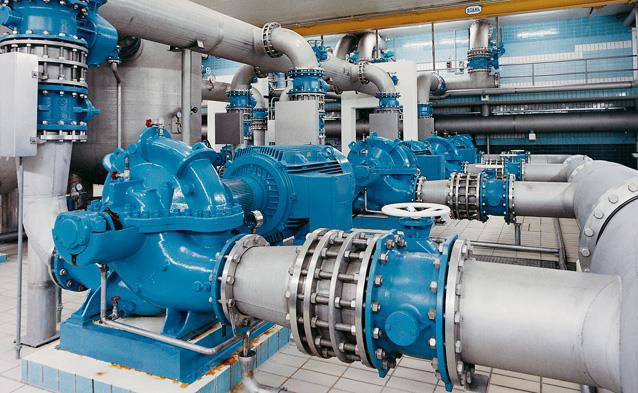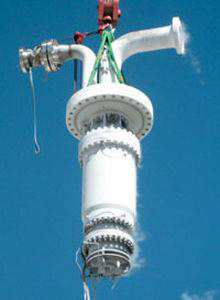PUMPS
A pump is a device that moves fluids (liquids or gases), or sometimes slurries, by mechanical action. Pumps can be classified into three major groups according to the method they use to move the fluid: direct lift, displacement, and gravity pumps. Pumps operate by some mechanism (typically reciprocating or rotary), and consume energy to perform mechanical work by moving the fluid. Pumps operate via many energy sources, including manual operation, electricity, engines, or wind power, come in many sizes, from microscopic for use in medical applications to large industrial pumps. Mechanical pumps serve in a wide range of applications such as pumping water from wells, aquarium filtering, pond filtering and aeration, in the car industry for water-cooling and fuel injection, in the energy industry for pumping oil and natural gas or for operating cooling towers. In the medical industry, pumps are used for biochemical processes in developing and manufacturing medicine, and as artificial replacements for body parts, in particular the artificial heart and penile prosthesis. Single stage pump – When a casing contains only one revolving impeller, it is called a single stage pump. Double/multi-stage pump – When a casing contains two or more revolving impellers, it is called a double or multi-stage pump. In biology, many different types of chemical and bio-mechanical pumps have evolved, and biomimicry is sometimes used in developing new types of mechanical pumps. Mechanical pumps may be submerged in the fluid they are pumping or be placed external to the fluid. Pumps can be classified by their method of displacement into positive displacement pumps, impulse pumps, velocity pumps, gravity pumps, steam pumps and valve less pumps.

There are two basic types of pumps: positive displacement and centrifugal. Although axial-flow pumps are frequently classified as a separate type, they have essentially the same operating principles as centrifugal pumps. A cryopump or a "cryogenic pump" is a vacuum pump that traps gases and vapors by condensing them on a cold surface, but are only effective on some gases. The effectiveness depends on the freezing and boiling points of the gas relative to the cryopump's temperature. They are sometimes used to block particular contaminants, for example in front of a diffusion pump to trap back streaming oil, or in front of a McLeod gauge to keep out water. In this function, they are called a cryotrap, water pump or cold trap, even though the physical mechanism is the same as for a cryopump. Cryotrapping can also refer to a somewhat different effect, where molecules will increase their residence time on a cold surface without actually freezing (super cooling). There is a delay between the molecule impinging on the surface and rebounding from it. Kinetic energy will have been lost as the molecules slow down. For example, hydrogen will not condense at 8 kelvin, but it can be cryotrapped. This effectively traps molecules for an extended period and thereby removes them from the vacuum environment just like cryopumping.


